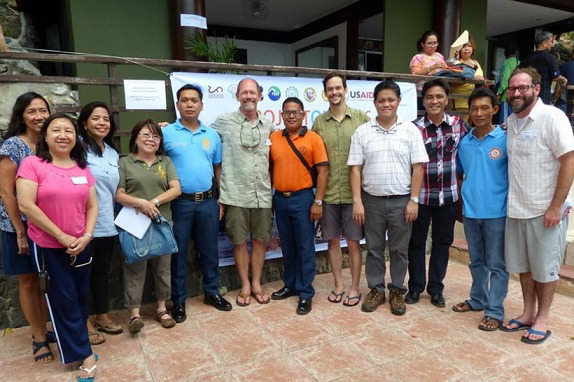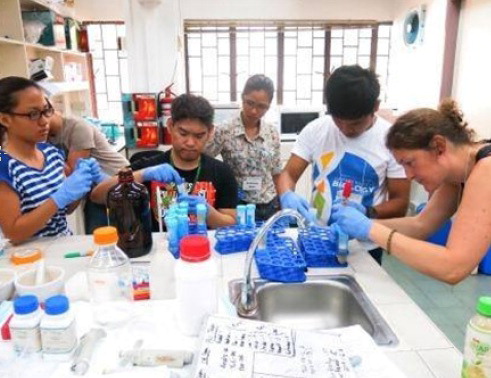The team collected samples of five species—
Scylla serrata, Stichopus horrens, Acanthochromis Polyacanthus, Katsuonus pelamis, Acropora hyacinthus—from predetermined locations within marine corridors of the Philippines and used sequencing techniques to establish their population structure and connectivity across the country.
The PEER project team and the U.S. partner and other U.S. researchers participated in a Pacific Advanced Science Institute at Siliman University in Dumaguete, where participants gave lectures on the applications of NextGen sequencing to studies on adaptation, biodiversity and conservation. The PEER researchers presented their work plan, receiving feedback from invited experts.
The team conducted three major training sessions on population genetics with 85 researchers and graduate students. The PEER project increased the number of people capable of conducting research on population structure and connectivity in the Philippines by helping one Master’s student to complete her degree, two doctoral students and two Master’s students to reach their final defense stage, and 13 undergraduates to complete their theses.
Two team members were awarded highly prestigious Fulbright grants: Dr. Ablan-Lagman received an advanced research and teaching fellowship for a stay of several months at Oregon State University, and PhD student Chona Camille Vince Cruz won a dissertation fellowship to pursue her research at the University of Washington from January through July 2016.
After facing challenges with a microsatellite marker, the researchers developed a semi-automated species identification system that later won the R&D Award competition of the Department of Science Technology Philippine Council for Industry, Energy, and Emerging Technologies
This project involved research undertaken by five separate institutions in the Philippines, developing a framework to strengthen national capability for marine natural resource management. The PEER grantees also reached a broader audience via the PhilGenes Diversity Network (PGDN), a community of researchers using molecular markers to study biodiversity in the Philippines, and its database. They also created a website, Philgenesdiversity.org, and a set of posters and brochures designed for a non-scientific audience to disseminate their results more broadly. Researchers also took part in the 1st National Mud Crab Congress, organized by the Southeast Asian Fisheries Development Center, presenting findings that may be helpful in managing wild stocks of mud crabs and cultured crabs for harvest.
PublicationsChona Camille Vince Cruz-Abeledo, Kenbert Ting, and Ma. Carmen Ablan-Lagman. 2018. Identification of a species diagnostic character for instar and juvenile mud crabs (Genus
Scylla).
Aquaculture 491: 205-209.
https://doi.org/10.1016/j.aquaculture.2018.03.035
Karen Camille Perez and Ma. Carmen Ablan-Lagman. 2016. Comparison of abundance and diversity of invertebrates in sediments from CO
2 and non-exposed reefs. Presented at the DLSU Research Congress 2016, De La Salle University, Manila, Philippines, March 7-9, 2016.
Louey Mari Ilustre and Maria Carmen Ablan-Lagman. 2015. Optimizing
Scylla serrata Karyotyping Methods. Presented at the DLSU Research Congress 2015, De La Salle University, Manila, Philippines, March 2-4, 2015.
C.C.E. Vince Cruz, G. Ramos, and M.C. Ablan-Lagman. 2015. Heavy metal levels in mud crabs (
Scylla spp.) from East Bataan Coast.
Environmental Science and Pollution Research 22(8): 6359-6363.
https://doi.org/10.1007/s11356-015-4194-3 Louey Mari Ilustre, Patricia Roa, Hilly Ann Roa-Quiaoit, and Maria Carmen Ablan-Lagman. 2014. Morphometric Comparison of
Dascyllus trimaculatus Populations from Bohol Sea, Philippines. Presented at the DLSU Research Congress 2014, De La Salle University, Manila, Philippines, March 6-8, 2014.
T.S. DeBoer, M.R.A. Naguit, M.V. Erdmann, M.C.A. Ablan-Lagman, Ambariyanto, K.E. Carpenter, A.H.A. Toha, and P.H. Barber. 2014. Concordance between phylogeographic and biogeographic boundaries in the Coral Triangle: conservation implications based on comparative analyses of multiple giant clam species.
Bulletin of Marine Science 90(1): 277-300.
http://dx.doi.org/10.5343/bms.2013.1003 T.S. DeBoer, M.R.A. Naguit, M.V. Erdmann, M.C.A. Ablan-Lagman, Ambariyanto, K.E. Carpenter, A.H.A. Toha, and P.H. Barber. 2014. Concordant phylogenetic patterns inferred from mitochondrial and microsatellite DNA in the giant clam
Tridacna crocea.
Bulletin of Marine Science 90(1): 301-329.
http://dx.doi.org/10.5343/bms.2013.1002 `
P.H. Barber, M.C.A. Ablan-Lagman, R.G. Berlinck, D. Cahyani, E.D. Crandall, R. Ravago-Gotanco, M.A. Juinio-Meñez, I.G. Ngurah Mahardika, K. Shanker, C.J. Starger, A.H.A. Toha, A.W. Wanggoro, and D.A. Willette. 2014. Advancing biodiversity research in developing countries: the need for changing paradigms.
Bulletin of Marine Science 90(1): 187-210.
http://dx.doi.org/10.5343/bms.2012.1108 J.M. Raynal, E.D. Crandall, P.H. Barber, G.N. Mahardika, M.C. Lagman, and K.E. Carpenter. 2014. Basin isolation and oceanographic features influencing lineage divergence in the humbug damselfish (
Dascyllus aruanus) in the Coral Triangle.
Bulletin of Marine Science 90(1): 513–532.
http://dx.doi.org/10.5343/bms.2013.1017 Oliver T. Paderanga. 2013. Morphological variation in the colonies of the hard coral
Acropora hyacinthus in sheltered and exposed conditions. In
Proceedings of the 45th Convention of the Federation of Institutions for Marine and Freshwater Sciences (FIMFS).






